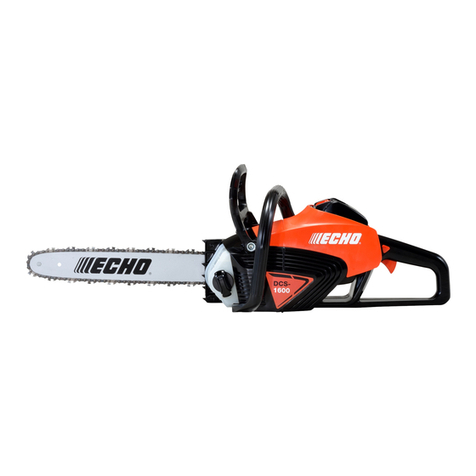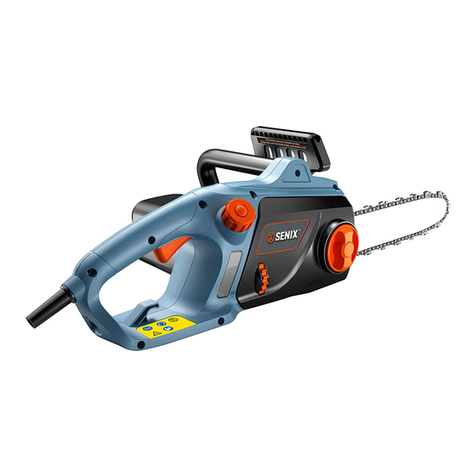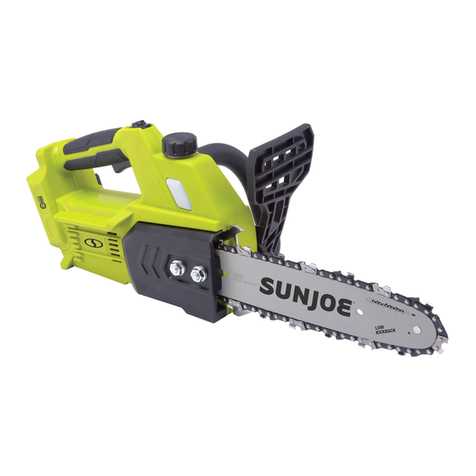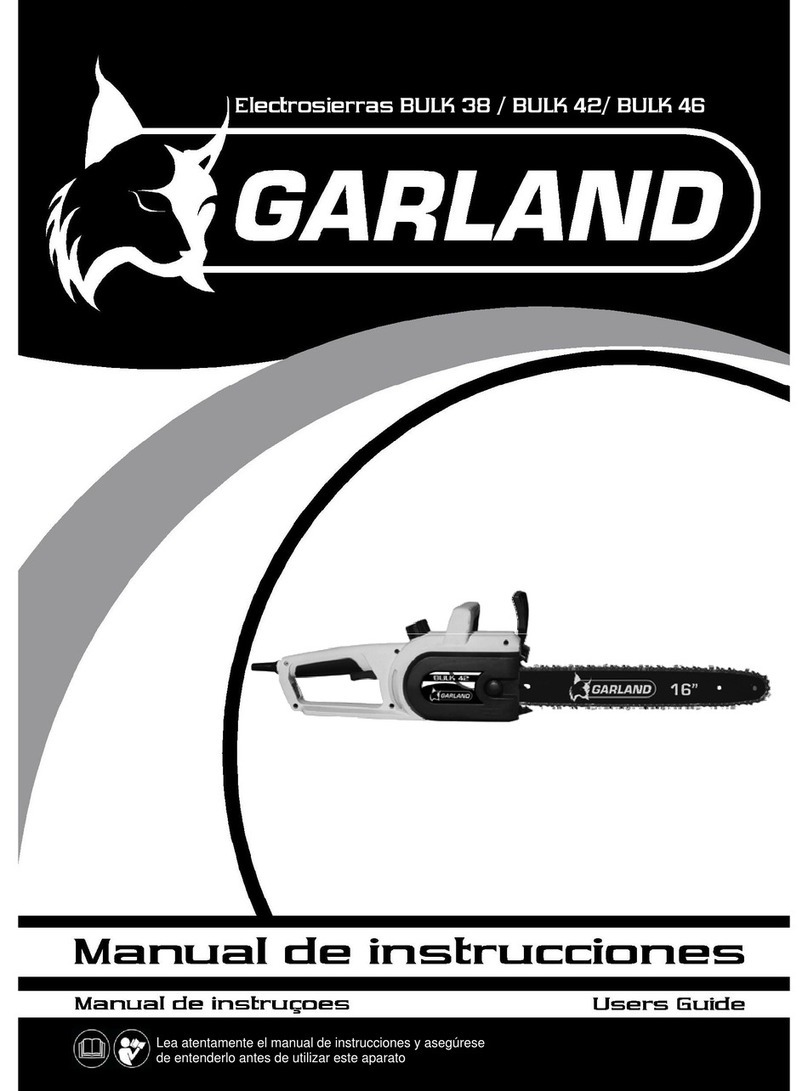CRAFTOP NT6260 User manual

Owner’s Manual
Chain Saw
NT6260
EXPERTS
IN EQUIPMENTS OF
GARDENING AND AGRICULTURE
ENGLISH
VERSION: 01-202106

We thank you for buying CRAFTOP Chain Saw
This chain saw provides advanced technology in incorporating many convenient features for you to perform your daily
cutting work.
Before attempting to use this chain saw, please read this manual carefully until you completely understand
and can follow all safety rules, precautions, operating and maintenance instructions. It will help you both to
become more familiar with this chain saw and to recognize and avoid situations that could endanger you and others.
Careless or improper use may cause serious or even fatal injury!
If you have any question about your chain saw and this manual, please contact CRAFTOP authorized dealer or
service center for your area. They always welcome your questions, suggestions, and constructive criticism.
We hope you enjoy this chain saw and wish you many years of safe and enjoyable cutting work.
CRAFTOP CANADA LTD.

|-1-
Table of contents
Guide to use this manual .............................................1
Product overview..........................................................3
Technical specification .................................................4
Safety features .............................................................5
Cutting equipments ......................................................8
Safety precautions and instructions ...........................10
Assembly....................................................................18
Fuel and fueling..........................................................20
Chain lubricant ...........................................................21
Start and stop the engine ...........................................22
Operation....................................................................24
Working techniques....................................................25
Maintenance and care................................................33
Storage....................................................................... 48
Disposal......................................................................48
Troubleshooting guide................................................49
Guide to use this manual
This Owner’s Manual refers to a CRAFTOP chain saw,
also called a machine in this Owner’s Manual.
All information, specifications, descriptions and
illustrations in this manual are as accurate as known at
the time of publication, but are subject to change
without notice. Due to ongoing product development,
there may be difference between your machine and the
information in this manual. No legal obligations or
commitments can be delivered from the information,
specifications, descriptions, or illustrations in this
manual.
Illustrations are only for orientation and are merely used
to help explain the text descriptions and instructions.
Illustrations may include optional equipment and
accessories, and may not include all standard
equipment.
Some signs or symbols on the machine may be a little
different refer to special certification requirements for
certain markets.
Any technical modifications to the machine that were
introduced after the editorial deadline please consult
your local dealer for more supplementary information.
All safety precautions and instructions described in this
manual should be observed during operation of the
chain saw, and all applicable federal, state and local
safety regulations, standards, and ordinances should
be observed as well.
Do not sell, lend or rent the machine without this
owner’s manual. Always be sure to include this owner’s
manual together with the machine, and make sure that
anyone using it understands all the information and
follows all the instruction contained in this manual.
Signs and symbols in this manual
DANGER
Texts with this symbol contain information regarding
hazardous situations which will cause death or severe
injures if not avoided.
WARNING
Texts with this symbol contain information regarding
hazardous situations which could cause death or
severe injures if not avoided.
CAUTION
Texts with this symbol contain information regarding
hazardous situations which could cause minor or
moderate injures if not avoided.
NOTICE
Texts with this symbol information regarding situation
which could cause chain saw damage if not avoided.
information
Texts with this symbol contain supplementary
information.
Read and understand the
Owner’s Manual.
It is very important that you read
this Owner’s Manual carefully,
make sure that you completely
understand and can follow all safety
rules, precautions, operating and
maintenance instructions before
attempting to use this chain saw,
failure to do so may cause serious
or even fatal injury!
Special safety precautions must be
observed to reduce personal injury
because it is a high-speed
wood-cutting tool with very sharp
edges.
Wear proper clothing.
Wear eye, ear and head
protection.
Always wear appropriate personal
protective equipments for chain saw
operation, inclusive of eye
protection, ear protection, and head
protection.
Face mask required.
Operators who are sensitive to dust
or other common airborne allergens
may need to wear a dust mask.

|-2-
Hands protection.
Always wear appropriate gloves for
chain saw operation.
Foot protection required.
Steel toe shoes with anti-slip sole
required in working area.
Fire hazard.
Risk of fire.
Highly flammable material.
No smoking.
Do not smoke in this area.
Sharp edges.
Watch you fingers.
Do not touch the saw chain while
the engine is running.
Hot surface.
Do not touch.
Switch off the engine by moving the
stop switch to the STOP position
before carrying out any checks or
maintenance.
Regular cleaning is required.
Visual check.
Protective glasses or a visor must
be worn.
Signs and symbols on the machine
For the purpose of safety operation and maintenance,
the meanings of signs and symbols may be attached to
or embossed on the machine.
CAUTION! Chain saws can be
dangerous! Careless or incorrect
use can result in serious or fatal
injury to the operator or others.
Please read the instructions
carefully and make sure you
understand them before using the
saw.
Always wear:
Approved protective helmet
Approved hearing protection
Protective glasses or visor
This product is in accordance with
applicable CE directives.
Fuel tank;
Fuel mixture of gasoline and engine
oil.
Engaging or disengaging the chain
brake.
H Carburetor adjustment.
-High speed mixture.
L Carburetor adjustment.
-Low speed mixture.
T Carburetor adjustment.
-Idle speed mixture.
Other signs or decals on the machine refer to special
certification requirements for certain markets.

|-3-
Product overview
General overview
1 Cylinder cover
2 Front handle
3 Front hand guard
4 Starter cover
5 Chain oil tank
6 Starter handle
7 Adjuster screw- carburetor
8 Choke control
9 Rear handle
10 Stop switch (Ignition on/off
switch)
11 Fuel tank
12 Muffler
13 Bar tip sprocket
14 Saw chain
15 Saw bar
16 Bumper
17 Chain catcher
18 Clutch cover
19 Right hand guard
20 Throttle control
21 Throttle lock
22 Combination spanner
23 Chain tensioning screw
24 Owner’s manual
25 Bar guard
26 Start throttle lock

|-4-
Technical specification
MODEL NT6260
Item Description Unit Specification
Overall
Package dimension
(L x W x H) inch/mm 22x20x14/560x515x355
Gross weight, without guide
bar and saw chain lbs/kg 38.5/17.5
Engine
Type Home use
Displacement cc 61.5
Bore inch/mm 1.9/48
Engine stroke type 2 stroke
Power kw/hp/rpm 2.6/3.6/8,500
Carburetor CRAFTOP
Starter Manual
Engine speed, Idle rpm 3,200±200
Engine speed
-clutch engagement rpm 4,000~4,600
Engine speed,
-wide open throttle rpm 11,500
Ignition system
Type CDI
Spark plug L6RTC / RCJ6Y(CHAMPION)
Electrode gap mm 0.35-0.50
Fuel system
Mixed ratio 40:1 (Gasoline : Oil)
Gasoline Minimum 90#
Oil CRAFTOP OIL
Tank capacity ml 650
Chain
lubrication
Lubrication oil type CRAFTOP CHAIN OIL
Tank capacity ml 350
Guide bar
Type Alloy
Sprocket Pitch 3/8inch, 7 teeth
Standard bar length in/mm 24”/610
Maximum cutting length in/mm 26”/660
Recommended bar length in/mm 24”/610
Groove width in/mm 0.065~0.071/1.65~1.8
Pitch in/mm 3/8”/9.525
Gauge in/mm 0.063”/1.6
Noise levels
Equivalent noise pressure
level dB(A) 110dB(A)
Equivalent noise power level dB(A) 110(LWA)dB(A)
Vibration levels Front handle m/s2Average 38.4

|-5-
MODEL NT6260
Item Description Unit Specification
Rear handle m/s2Average 37.5
3/8”
9.525mm
0.065” ~0.071”
1.6mm~1.8mm
13/64”
5.2mm 60°
25° 10°
0.025”
0.65mm
15”/38:56,16”/41:60
18”/46:48,20”/51:72
24”/61:70
information
Specifications, descriptions and illustrations in this manual are as accurate as known at the time of publication, but are
subject to change without notice.
Safety features
Chain brake and front hand guard
Our chain saw is equipped with a chain brake that is
designed to stop the chain immediately if you get a
kickback. The chain brake can reduce the risk of
accidents, but only you can prevent it. Do not assume
that the chain brake itself will protect you in the event of
a kickback.
WARNING
Take care and make sure the kickback zone of the
chain bar never touches any object when using your
chain saw.
The chain brake (A) can either be activated manually
(by your left hand) or automatically by the inertia
release mechanism (a free- swinging pendulum). On
most of our models the front hand guard acts as a
counterweight in case of kickback.
A
B
The brake is applied when the front hand guard (B) is
pushed forwards.
B

|-6-
This movement activates a spring-loaded mechanism
that tightens the Brake Band (C) around the engine
drive system (D) (Clutch Drum).
B
C
D
The front hand guard is not designed solely to activate
the chain brake. Another important safety feature is that
it prevents the chain from hitting your left hand if you
lose your grip on the front handle.
You can also use the chain brake as a temporary brake
when you change position or if you put the saw down
for a short time. You should also apply the chain brake
manually if there is a risk of the chain accidentally
hitting anyone or anything close by.
To release the chain brake pull the front hand guard
backwards, towards the front handle.
The inertia activated chain brake increases your safety,
but there are certain factors to remember. The way the
chain brake is triggered, either manually or
automatically, depends on the force of the kickback and
the position of the chain saw in relation to the object
that the kickback zone of the bar strikes.
If you get a violent kickback while the kickback zone of
the bar is farthest away from you the chain brake will be
activated by the movement of the counterweight
(INERTIA ACTIVATED).
If the kickback is less violent or the kickback zone of the
bar is closer to you the chain brake will be activated
manually by the movement of your left hand.
During felling your left hand grasps the front handle in
such a way that it cannot activate the front hand guard.
In this position the chain brake can only be activated by
the inertia action of the counterweight.
Throttle lock
The throttle lock is designed to prevent accidental
operation of the throttle control. When you press the

|-7-
lock (A) (i.e. when you grasp the handle) it releases the
throttle trigger (B).
When you release the handle the throttle trigger and the
throttle lock both move back to their original positions.
This movement is controlled by two independent return
springs.
This arrangement means that the throttle control is
automatically locked at the idle setting when you
release the handle.
A
B
Chain catcher
The chain catcher is designed to catch the chain if it
snaps or jumps off. This should not happen if the chain
is properly tensioned and if the bar and chain are
properly serviced and maintained.
Right hand guard
Apart from protecting your hand if the chain jumps or
snaps, the right hand guard stops branches and twigs
from interfering with your grip on the rear handle.
Vibration damping system
Your chain saw is equipped with a vibration damping
system that is designed to minimize vibrations and
make operation more comfortable and easier to work
with this machine.
When you use a chain saw vibrations are generated by
the uneven contact between the chain and the wood
you are cutting.
Cutting hardwoods (most broadleaf trees) creates more
vibration than cutting softwoods (most conifers). Cutting
with a chain that is blunt or faulty (wrong type or badly
sharpened) will increase the vibration level.
The vibration damping system reduces the vibrations
transmitted from the engine and chain to the handles of
the chain saw. The body of the saw, including the
cutting equipment, is insulated from the handles by
vibration damping units.
WARNING
Exposure to vibrations through prolonged use of
gasoline powered hand tools could cause blood vessel
or nerve damage in the fingers, hands, and joints of
people prone to circulation disorders or abnormal
swellings. Prolonged use in cold weather has been
linked to blood vessel damage in otherwise healthy
people. If symptoms occur such as numbness, pain,
loss of strength, change in skin color or texture, or loss
of feeling in the fingers, hands, or joints, stop the use of
this machine and contact your doctor immediately. An
anti-vibration system does not guarantee the avoidance
of these problems. Owners who operate power tools on

|-8-
a continual and regular basis must monitor closely their
physical condition and the condition of this tool.
Stop switch
Use the stop switch to shut off the engine.
Muffler
The muffler is designed to keep noise levels to a
minimum and to direct exhaust fumes away from the
operator.
WARNING
The exhaust fumes from the engine are hot and may
contain sparks which can start a fire. Never start the
saw indoors or near combustible material!
In areas with a hot, dry climate there is a high risk of
forest fires. These areas are sometimes controlled by
legislation and requirements that among other things
the muffler (A) must be equipped with an approved type
of spark arrestor mesh (B).
A
B
WARNING
The muffler gets very hot in use and remains so for a
short time afterwards. Do not touch the muffler if it is
hot!
Kickback safety features
WARNING
The following features are included on your saw to help
reduce the hazard of kickback; however, such features
will not totally eliminate this danger. As a chain saw
owner, do not rely only on safety devices. You must
follow all safety precautions, instructions, and
maintenance in this manual to help avoid kickback and
other reactive forces which can result in serious or even
fatal injury.
•
Reduced-Kickback Guide Bar, designed with a small
radius tip which reduces the size of the kickback
danger zone on the bar tip. A Reduced-Kickback
Guide Bar has been demonstrated to significantly re
duce the number and seriousness of kickbacks.
-
Reduced Kickback Symmetrical Guide Bar
-
Symmetrical Guide Bar
•
Front Hand Guard, designed to reduce the chance of
your left hand contacting the chain if your hand slips
off the front handlebar.
•
Position of front and rear handlebars, designed with
distance between handles and in-line with each other.
The spread and in-line position of the hands provided
by this design work together to give balance and
resistance in controlling the pivot of the saw back
toward the operator if kickback occurs.
WARNING
Do not rely upon any of the devices built into your chain
saw, you should use the machine properly and carefully
to avoid kickback.
Reduced-kickback guide bars and low-kickback saw
chain reduce the chance and magnitude of kickback
and are recommended. Repairs on a chain brake
should be made by authorized dealer or service center.
Take your machine to the place of purchase if
purchased from an authorized dealer, or to the nearest
authorized service center.
•
Tip contact in some cases may cause a lightning fast
reverse REACTION, kicking the guide bar up and
back toward the operator.
•
Pinching the saw chain along the top of the guide bar
may push the guide bar rapidly back toward the
operator.
•
Either of these reactions may cause you to lose
control of the chain saw which could result in serious
injury. Do not rely exclusively upon the safety devices
built into your chain saw.
•
Chain Brake, designed to stop the chain in the event
of kickback.
Cutting equipments
This section describes how to choose and maintain
your cutting equipments in order to:

|-9-
•
Reduce the risk of kickback.
•
Reduce the risk of the chain breaking or jumping.
•
Obtain maximum cutting performance.
•
Extend the life of cutting equipment.
5 basic rules
1. Only use cutting equipment recommended by us!
Detail see the section of technical specification.
2. Keep the chain cutting teeth properly sharpened!
Follow our instructions and use the recommended
file gauge. A damaged or badly sharpened chain
increases the risk of accidents.
3. Maintain the correct raker clearance! Follow our
instructions and use the recommended raker
gauge. Too large clearance increases the risk of
kickback.
4. Keep the chain properly tensioned! If the chain is
slack it is more likely to jump off and lead to
increased wear on the bar, chain and drive
sprocket.
5. Keep cutting equipment well lubricated and
properly maintained! A poorly lubricated chain is
more likely to break and lead to increased wear on
the bar, chain and drive sprocket.
Cutting equipments designed to
minimize kickback
WARNING
Faulty cutting equipment or the wrong combination of
bar and chain increases the risk of kickback. Use only
the bar and chain combinations recommended in the
section of Technical specification.
The only way to avoid kickback is to make sure that the
kick- back zone of the bar never touches anything. By
using cutting equipment with “built-in” kickback
protection and keeping the chain sharp and
well-maintained you can reduce the effects of kickback.
A. Bar
The smaller the tip radius the smaller the kickback zone
and the lower the chance of kickback.
B. Saw chain
A saw chain is made up of a number of links, which are
available in standard and low-kickback versions.
None Standard Low-kickback
CUTTING LINK
DRIVE LINK
SIDE LINK
Combining these links in different ways gives different
degrees of kickback reduction. In terms of kickback
reduction alone, four different types of link are
available.
Kickback reductio n Cutting lin k Drive link Side link
LOW
STANDARD
HIGH
EXTRA HIGH
C. Some terms that describe the bar and chain

|-10-
When the cutting equipment supplied with your saw
becomes worn or damaged you will need to replace it.
Use only the type of bar and chain recommended in the
section of Technical specification.
•
Bar
-
LENGTH (inches/cm).
-
NUMBER OF TEETH ON BAR TIP SPROCKET
(T).. Small number = small tip radius = low-kickback
-
CHAIN PITCH (inches). The spacing between the
drive links of the chain must match the spacing of
the teeth on the bar tip sprocket and drive sprocket.
PITCH=D/2.
-
NUMBER OF DRIVE LINKS The number of drive
links is determined by the length of the bar, the
chain pitch and the number of teeth on the bar tip
sprocket.
-
BAR GROOVE WIDTH (inches/mm). The groove in
the bar must match the width of the chain drive
links.
-
SAW CHAIN OIL HOLE AND HOLE FOR CHAIN
TENSIONER. The bar must be matched to the
chain saw design.
•
Saw chain
-
SAW CHAIN PITCH (=PITCH) (inches)
-
DRIVE LINK WIDTH (mm/inches)
-
NUMBER OF DRIVE LINKS
-
LEVEL OF KICKBACK REDUCTION. The level of
kickback reduction offered by a chain is indicated
by its model number.
Safety precautions and instructions
Special safety precautions must be
observed when working with a chain
saw because it is high-speed
wood-cutting tool with very sharp
cutters. Careless or improper use may
cause serious or even fatal injury.
Before attempting to use this chain
saw, please read this manual
carefully until you completely
understand and can follow all safety
rules, precautions, operating and
maintenance instructions.
Safety precautions
WARNING
•
Observe all applicable local safety regulations,
standards and ordinances.
•
If you have not used this type of chain saw before,
have your dealer or other experienced user show you
how to operate your machine.
•
Because a chain saw is high-speed wood-cutting tool,
some special precautions must be observed to
reduce the risk of accident and personal injury.
Careless or improper use may cause serious or even
fatal injury.
•
The use of this chain saw may be hazardous. The
saw chain has many sharp cutters. If the sharp edge

|-11-
contacts your body, they will cut you, even if the saw
chain is not moving.
•
Pay special attention to reactive forces, inclusive of
kickback, because it is very dangerous.
•
The exhaust from this machine may contain
chemicals known by the State of California to cause
cancer, birth defects or other reproductive harm.
•
The noise emitted from this machine may be
restricted to certain times by national or local
regulations.
•
Use this chain saw only for wood cutting. Do not use
it for other purpose, since misuse may result in
personal injury or property damage, including
damage to the chain saw.
•
Your chain saw is a one-person-operated machine.
Do not allow other persons in the general work area,
even when starting. Stop the engine immediately if
you are approached.
•
Minors should never be allowed to use this chain saw.
Do not allow other persons near the chain saw when
starting or cutting. Keep bystanders, especially
children, and animals out of the work area. Keep
bystanders, children, and animals a minimum of 50
feet (15m) from the work area.
•
The person who use this chain saw must be in good
physical condition and mental health, and not under
the influence of alcohol and drugs. Never use this
chain saw when you are fatigued, sick, or upset. If
you feel tired, take a break.
•
The components of this machine generate an
electromagnetic field during operation, which may
interfere with some pacemakers. To reduce the risk of
serious or fatal injury, persons with pacemakers
should consult with their physician and the
pacemaker manufacturer before operating this
machine. In the absence of such information,
CRAFTOP does not recommend the use of this
machine by anyone who has a pacemaker.
•
The owner of this machine is responsible for avoiding
injury to third parties or damage to their property.
CAUTION
Prolonged exposure to cold and/or vibration may result
in injury. Read and follow all safety and operation
instructions to minimize risk of injury. Failure to follow
instructions may result in painful wrist/hand/arm
injuries.
Raynaud’s Phenomenon may affect the fingers of
certain individual if a person is exposed to vibration and
cold. Exposure to vibration and cold may cause tingling
and burning sensations, followed by loss of color and
numbness in the fingers. The following precautions are
strongly recommended:
•
Keep your body warm, especially the head, neck,
hands, wrists, ankles and feet, ,.
•
Maintain good blood circulation by performing
vigorous arm exercises during frequent work breaks.
•
Limit the hours of operation, have a rest when you
feel tired or fatigued.
•
If you experience discomfort, redness, and swelling of
the fingers followed by whitening and loss of feeling,
consult your physician before continuing exposing
yourself to cold and vibration.
Overusing the muscles and tendons of the fingers,
hands, arms, and shoulders may cause soreness,
swelling, numbness, weakness, and extreme pain in
those areas.
•
Avoid using your wrist in a bent, extended, or twisted
posture. Instead, try to maintain a straight wrist
position. Also, when grasping, use your whole hand,
not just the thumb and index finger.
•
Take periodic breaks to minimize repetition and let
your hands have a rest.
•
Reduce the speed and force with which you do the
repetitive movement.
•
Do exercise to strengthen your hands and arm
muscles.
•
Immediately stop using the machine and other power
tools, and consult a doctor if you feel tingling,
numbness, or pain in the fingers, hands, wrists, or
arms.
DANGER
All over head electrical conductors and communications
wires can have electricity flow with high voltages. This
machine is not insulated against electrical current.
Never touch wires directly or indirectly, otherwise
serious injury or even death may result.
DANGER
Do not operate this machine indoors or in inadequately
ventilated areas. Engine exhaust contains poisonous
emissions and can cause serious injury or death.
Clothing and PPE
Wear proper clothing.
Wear eye, ear and head
protection.
Always wear appropriate personal
protective equipments for chain saw
operation, inclusive of eye
protection, ear protection, and head
protection.
Face mask required.
Operators who are sensitive to dust
or other common airborne allergens
may need to wear a dust mask.
Hands protection.
Always wear appropriate gloves for
chain saw operation.

|-12-
Foot protection required.
Steel toe shoes with anti-slip sole
required in working area.
WARNING
Most chain saw accidents happen when the saw chain
touches the operator. You must wear approved clothing
and approved personal protective equipments (PPE)
whenever you use a chain saw.
Proper clothing.
Clothing must be sturdy but allow
complete freedom of movement.
Wear snug-fitting clothing, a type of
overalls, long pants or chaps that
contain pads of cut-retardant
material. Avoid clothing that could
get caught on branches or brush or
moving parts of the machine. Do
not wear a loose-fitting jacket, scarf,
necktie, jewelry, flared or cuffed
pants. Tie up and confine long hair
with a hair net or cap, so it is
secured above shoulder level.
Ear, eye and head protection
Always wear appropriate personal
protective equipments for chain saw
operation, inclusive of eye
protection, ear protection, and head
protection.
Hands protection
Always wear heavy-duty work
gloves made of durable material
(e.g. leather) for chain saw
operation.
Foot protection.
Wear sturdy boots with saw
protection, steel toe and non-slip
soles in your working area.
Always have a first aid kit at your
working place
Personal protective equipments can not eliminate the
risk of injury, but it will reduce the degree of injury if an
accident does happen. Ask your chain saw dealer for
help in choosing the right equipments.
Long-time or continuous exposure to high noise levels
may cause permanent hearing impairment. Always
wear approved hearing protection when operating a
chain saw.
Handle your chain saw safely
WARNING
This chain saw must only be used to trim hedges or
shrubs with thinner branches. Do not use the machine
to cut trees, thick branches, grass, solid metal, sheet
metal, plastic, or any other types of material.
Do not use the chain saw as a lever to lift, move or
break objects, nor lock it on fixed supports.
Under any circumstance, you should not modify the
original design of the chain saw without approval from
CRAFTOP. Always use genuine spare parts.
Unauthorized modifications or accessories may lead to
serious or even fatal injury.
Under any circumstance, you should not operate your
chain saw if it is damaged, improperly adjusted or
maintained, or not completely or securely assembled.
Always inspect the chain saw before each use, and
replace the parts immediately if it is worn, loose,
damaged or missing.
•
Always disconnect spark plug wire and place wire
where it can not contact spark plug to prevent
accidental starting when setting up, transporting,
adjusting or making repairs except carburetor
adjustments.
•
Always hold the chain saw firmly with two hands
when the engine is running. Do not operate a chain
saw with one hand. Serious injury to the operator,
helpers, bystanders or any combination of these
persons may result from one-handed operation. The
chain saw MUST be used with two hands! Place
your left hand on the front handle and your right hand
on the rear handle, with your thumbs and fingers
tightly encircling the handles.
•
Operate the chain saw only in a well-ventilated
outdoor area. Never start or run the engine inside a
closed room or building. Exhaust fumes contain
dangerous carbon monoxide.
•
Never operate the machine at night, at times of heavy
fog, or at any other times when your field of vision
might be limited and it would be difficult to maintain a
clear view of the working area.
•
During rain, storms at times of strong or gale-force
winds, or at any other times when weather conditions
might make it unsafe to use this machine.
•
Carefully plan your cutting operation in advance.
Never start cutting until you have a clear work area.

|-13-
•
Maintain footing and balance at all times. Do not
stand on slippery, uneven or unstable surfaces. Do
not operate the chain saw in odd position or on a
ladder or ladders.
•
Always shut off the engine before putting the chain
saw down.
•
Keep exhaust area clear of flammable debris. Avoid
contact hot surfaces during and immediately after
operation.
•
Use a damp cloth, soft bristle brush, and/or air
compressor (Max 25 PSI) to clear your chain saw. Do
not use a pressure washer to clean chain saw as the
solid jet of high pressure water may damage parts of
the machine.
Maintain in good work order
Switch off the engine by moving the
stop switch to the STOP position
before carrying out any checks or
maintenance.
Regular cleaning is required.
Visual check.
Protective glasses or a visor must
be worn.
CAUTION
All chain saw service, other than the items listed in the
maintenance section of this manual, should be
performed by authorized service dealer or competent
chain saw service personnel.
WARNING
Only use high-quality replacement parts in order to
avoid the risk of accidents and damage to the power
tool. If you have any questions in this respect, consult
an authorized dealer or service center. CRAFTOP
recommends the use of genuine spare parts. They are
specifically designed to match your model and meet
your performance requirements.
•
Make sure that the saw chain stops moving when the
throttle control trigger is released.
•
Keep the handles dry, clean, and free of oil or fuel
mixture.
•
Keep fuel and oil caps, screws, and fasteners
securely tightened.
•
To reduce the risk of injury, always shut off the engine
before carrying out any maintenance or repairs or
cleaning the machine, only excepts carburetor and
idle speed adjustments.
•
Check the machine for loose/missing nuts, bolts, and
screws. Tighten and/or replace as needed.
•
Check that the cutting attachment is firmly attached
and in safe operating condition.
•
Do not turn the engine over on the starter with the
spark plug boot or spark plug removed since there is
otherwise a risk of fire from uncontained sparking.
•
Check fuel system for leaks due to fuel tank damage,
especially if the machine is dropped accidently. If
damages or leaks are found, do not use the machine
any more, otherwise serious personal injury or
property damage may occur. Have your machine
repaired by authorized dealer or service center before
next use.
•
Check the fuel filler cap for leaks at regular intervals.
•
To reduce the risk of fire, do not service or store your
machine near open flames.
•
Use only a spark plug type which is approved by
CRAFTOP and make sure it is in good condition.
•
Check the condition of the muffler. To reduce the risk
of fire and damage to hearing, do not operate your
machine if the muffler is damaged or missing.
•
Do not touch a the muffler, spark plug, or other
metallic parts of the engine while the engine is
running or immediately shutting down, otherwise burn
injury will result.
Reduce the chance of kickback
WARNING
Kickback can happen very suddenly and violently;
kicking the saw, bar and chain back at the operator. If
this happens when the chain is moving, it can cause
very serious or even fatal injuries. It is vital that you
understand what causes kickback and that you can
avoid it by taking care and using the right working
technique.
The word kickback is used to describe the sudden
reaction that happens when the upper quadrant of the
tip of the bar (known as the "kickback zone") touches
an object and the saw is kicked backwards. Kickback
only occurs if the kickback zone of the bar touches an
object.
Kickback may occur when the moving saw chain near
the upper quadrant of the guide bar nose contacts any
object such as a log or branch, or when the wood
closes in and pinches the saw chain in the cut. Note

|-14-
that contacting a foreign object in the wood can also
result in loss of chain saw control.
Kickback always occurs in the cutting plane of the saw.
Normally the saw and bar are thrown backwards and
upwards towards the operator. However the saw may
move in a different direction depending on the way it
was being used when the kickback zone of the bar
touched the object.
Take great care when you cut with the top edge of the
bar, i.e. when cutting from the underside of the object.
This is known as cutting on the push stroke. The chain
tries to push the saw back towards the operator. Unless
the operator resists this pushing force there is a risk
that the saw will move so far backwards that only the
kickback zone of the bar is in contact with the tree. This
will cause kickback.
•
Rotational Kickback can occur when the moving
chain contacts an object at the up- per tip of the guide
bar. This contact can cause the chain to dig into the
object, which stops the chain for an instant. The result
is a lightning fast, reverse reaction which kicks the
guide bar up and back to- ward the operator.
•
Pinch-Kickback can occur when the wood closes in
and pinches the moving saw chain in the cut along
the top of the guide bar and the saw chain is suddenly
stopped. This sudden stopping of the chain results in
a reversal of the chain force used to cut wood and
causes the saw to move in the opposite direction of
the chain rotation. The saw is driven straight back
toward the operator.
•
Pull-ln can occur when the moving chain contacts a
foreign object in the wood in the cut along the bottom
of the guide bar and the saw chain is suddenly
stopped. This sudden stopping pulls the saw forward
and away from the operator and could easily cause
the operator to lose control of the chain saw.
•
Avoid Pinch-Kickback:
-
Be extremely aware of situations or obstructions
that can cause material to pinch the top of or
otherwise stop the chain.
-
Do not cut more than one log at a time.
-
Do not twist the saw as the bar is with- drawn from
an undercut when bucking.
•
Avoid Pull-In:
-
Always begin cutting with the engine at full speed
and the saw housing against wood. S Use wedges
made of plastic or wood.
-
Never use metal to hold the cut open.
•
Reduce the chance of kickback
Recognize that kickback can happen. With a basic
understanding of kickback, you can reduce the element
of surprise which contributes to accidents.
-
Most kickback accidents happen during limbing.
Make sure you are standing firmly and that there is
nothing in the way that might make you trip or lose
your balance. Lack of concentration can lead to
kickback if the kickback zone of the bar accidentally
touches a branch, nearby tree or some other object.
-
Cutting with the bottom edge of the bar, i.e. from
the top of the object downwards, is known as
cutting on the pull stroke. In this case the saw pulls
itself towards the tree and the front edge of the saw
provides a natural rest when cutting. Cutting on the
pull stroke gives you better control over the saw
and the position of the kickback zone.
-
Never let the moving chain contact any object at the
tip of the guide bar.

|-15-
-
Keep the working area free from obstructions such
as other trees, branches, rocks, fences, stumps, etc.
Eliminate or avoid any obstruction that your saw
chain could hit while you are cutting. When cutting a
branch, do not let the guide bar contact branch or
other objects around it.
-
Keep your saw chain sharp and properly tensioned.
A loose or dull chain can increase the chance of
kickback occurring. Check tension at regular
intervals with the engine stopped, never with the
engine running. Make sure the chain brake nuts are
securely tightened after tensioning the chain. When
you replace the bar and chain use only
combinations that are recommended by CRAFTOP.
-
Begin and continue cutting at full speed. If the chain
is moving at a slower speed, there is greater
chance of kickback occurring.
-
Cut one log at a time.
-
Use extreme caution when reentering a previous
cut.
-
Do not attempt cuts starting with the tip of the bar
(plunge cuts).
-
Watch for shifting logs or other forces that could
close a cut and pinch or fall into chain.
-
Use the Reduced-Kickback Guide Bar and
Low-Kickback Chain specified for your chain saw.
WARNING
The risk of kickback is increased if you use the wrong
cutting equipment or a chain that is not sharpened
correctly. The wrong combination of bar and chain can
increase the risk of kickback!
Maintain good control of chain saw
WARNING
To reduce the risk of serious or even fatal injury to the
operator or bystanders from loss of control, never use
the chain saw with one hand. Always hold the chain
saw firmly with both hands when the engine is running.
WARNING
To reduce the risk of cutting injuries, keep hands and
feet away from the cutting tool. Never touch a moving
tool with your hand or any other part of your body.
Keep a good, firm grip on the chain saw with both
hands when the engine is running and Don’t let go. A
firm grip will help you reduce kickback and maintain
control of the saw.
•
Always place your left hand on the front handle and
your right hand on the rear handle. Never reverse
right and left hand positions for any type of cutting
whether your are right handed or left handed.
•
Position your left hand on the front handle bar so it is
in a straight line with your right hand on the rear
handle when making bucking cuts. Keep your left arm
straight with the elbow locked.
•
Wrap your fingers and thumb around the hand- les.
You should use this grip whether you are
right-handed or left- handed. This grip minimizes the
effect of kickback and lets you keep the saw under
control. Do not let go of the handles!
•
Keep proper footing and balance at all times. Stand
with your weight evenly balanced on both feet. Stand
slightly to the left side of the saw to keep your body
from being in a direct line with the cutting chain.
•
Pay special caution when working on slippery ground,
slopes, or uneven ground.
•
Do not overreach. Do not cut above shoulder height,
and not try to cut with the tip of the saw bar. It is
difficult to maintain control of chain saw above
shoulder height.
•
To reduce the risk of injury from loss of control, never
work on a ladder or any other insecure support,
otherwise you could be drawn or thrown off balance
and lose control of the chain saw.
•
Never put pressure on the chain saw when reaching
the end of a cut. The pressure may cause the bar and
rotating saw chain to pop out of the cut or kerf, go out
of control and strike the operator or some other object.
If the rotating saw chain strikes some other object, a
reactive force may cause the moving saw chain to
strike the operator.
Transporting your chain saw
WARNING
Always stop the engine before putting the chain saw
down. Carrying a chain saw with the engine running
may be extremely dangerous.
Accidental acceleration of the engine can cause the
saw chain to rotate. Always engage the chain brake
when taking the machine more than a few steps.

|-16-
•
When transporting your chain saw by hand, the
engine must be shut off, the chain brake must be
engaged, and the saw chain and guide bar must be
covered with the chain guard (scabbard) and in the
proper position (for example, grip the top handle,
place the muffler away from your body, and the saw
chain to the rear). Avoid touching hot parts of the
machine, especially the muffler and gear housing,
otherwise you could suffer serious burns.
•
When transporting your chain saw in a vehicle, the
saw chain and guide bar should be covered with the
chain guard (scabbard) and properly secured to avoid
turnover, fuel spillage and damage to your machine.
Handle fuel with caution
You chain saw use a gasoline-oil mixture for fuel.
WARNING
Gasoline is an extremely flammable fuel. Pay high
attention when mixing, storing or handling, otherwise
serious personal injury may result.
If spilled and ignited by a spark or
other ignition source, gasoline can
cause fire and serious burn injury or
property damage.
Do not smoke or bring any fire or
flame while handling fuel or while
operating the chain saw. Note that
combustible fuel vapor may escape
from the fuel system.
•
Mix and pour fuel in a well ventilated outdoor area on
bare ground; store fuel in a cool, dry well ventilated
place; and use an approved, marked container for all
fuel purposes. Wipe up all fuel spills before starting
the chain saw.
•
Eliminate all sources of sparks or flame(i.e. smoking,
open flames, or work that can cause sparks) in the
areas where fuel is mixed, poured, or stored. Always
shut off the engine and allow it to cool down before
refueling.
•
Always use with caution when handling fuel. Wipe up
all spills and then move the chain saw at least 10feet
(3 meters) from the fueling point before starling the
engine.
•
To reduce the risk of fire and explosion, fuel your
machine only in a well-ventilated area, outdoors away
from flames, pilot lights, heaters, electric motors, and
other sources of ignition
•
Always shut off the engine before refueling, let the
machine cool down in a non-combustible area, not on
dry leaves, straw, paper, etc. Do not fuel a hot engine
because fuel may spill out and cause a fire.
•
Loose a bit of the fuel cap carefully so as to allow any
pressure build-up in the fuel tank to release slowly
and avoid fuel spillage.. Never remove the fuel cap
when engine is running!
•
If you spill fuel, wipe the machine immediately. If fuel
spills on your clothing, change it immediately.
•
Tight the fuel cap securely to the proper position,
make sure it does not loosen or come off due to the
machine vibrations.
•
To reduce the risk of serious or fatal burn injuries,
check for fuel leakage. If fuel leakage is found, do not
start or run the engine until leak is fixed.
•
Do not inhale fuel fumes as they are toxic.
•
Store the machine and fuel in an area where fuel
vapors cannot reach sparks or open flames from
water heaters, electric motors or switches, furnaces,
etc.
Before starting the engine
A area within a minimum radius of 50feet (15m) from
the using the machine should be considered as a
hazardous area, into which on one should enter. If
necessary, yellow warning rope and warning signs
should be placed around the perimeter of the area.
When work is to be performed simultaneously by two or
more persons, special care should also be taken to
constantly look around or otherwise check for the
presence and locations of other people working, so as
to maintain sufficient safety distance between each
person.
Before starting the engine, take off the chain guard
(scabbard), and check that your machine is properly
assembled and in good condition
•
Check cutting equipment is correctly fitted and
adjusted.
•
Check the fuel system for leaks, paying high attention
to visible parts such as the fuel tank cap, hose
connections and the manual fuel pump (if equipped).
If there are any leaks or damage, do not start the
engine because of potential risk of fire. Have your
machine repaired by an authorized dealer or service
center before using it again.
•
The engine stop switch must move easily in direction
of STOP position and spring back to the normal
START position.
•
Smooth action of throttle trigger lockout and throttle
trigger - The throttle trigger must return automatically
to the idle position by itself.
•
Check that the spark plug boot is secure – a loose
boot may cause arcing that could ignite combustible
fumes and cause a fire.
•
Saw chain securely mounted and in good condition
(clean, move freely, not warped, properly sharpened).
•
Never attempt to modify the controls or safety devices
in any way.

|-17-
•
Keep all handles dry and clean, free from oil and dirt
– for safe control of the machine.
•
To reduce the risk of accidents, do not operate your
machine if it is damaged or not properly assembled.
When starting the engine
WARNING
Note that the saw chain continue to run for a short
period after you let go of the throttle trigger, due to
flywheel effect.
•
Start the engine at least 10feet (3m) from the fueling
spot, outdoors only.
•
Keep bystanders, especially children and animals at
least 50feet (15m) from the operating point. If you are
approached, immediately stop the engine.
•
Place the machine on firm ground in an open and well
ventilated area. Make sure you have good balance
and secure footing. Hold the machine securely. The
saw chain must not contact the ground and all other
obstructions because they may begin to run when the
engine starts.
•
Your machine is designed to be operated by one
person only. Do not allow other persons in the work
area even when starting.
•
To reduce the risk of injury, avoid contact with the
saw chain.
•
Do not drop start the power tool, just follows the way
and start the engine as described in this manual.
•
Never start the engine by standing on the cutting
attachments side.
•
Check idle speed setting: The saw chain must not
move when the engine is idling with the throttle trigger
released. If it continues to move even after the throttle
trigger has been completely released, shut off the
engine and take the machine to your authorized
dealer or service center for inspection and/or repair.
information
When a new machine is first operated, in the first few
minutes grease may come out of the gear case. But,
since this is excessive grease, there is no cause of
alarm. Just wipe it off with the engine stopped for next
use
During operation
WARNING
Moving parts can amputate fingers or cause severe
injuries. Keep hands, clothing and loose objects away
from all moving parts. Always stop engine, disconnect
spark plug, and make sure all moving parts have come
to a complete stop before removing obstructions,
clearing debris, or servicing unit.
Do not touch any moving parts,
especially the saw chain, while the
motor is running. If the saw chain
become jammed by thick branches
or other obstructions, switch off the
engine immediately before
attempting to free the saw chain –
there is otherwise a risk of injury.
Hot surface.
Do not touch.
•
Always carry related tools, equipments, spare parts,
and consumables with you:
-
Attached tools in the product package.
-
Personal protective equipments.
-
Properly reserved fuel
-
Spare parts.
-
Things to notify your working are (rope, warning
signs, etc.).
-
Whistle (for collaboration or emergency).
-
Hatchet or saw (for removal of obstacles).
•
Check that there are no bystanders, children, and
animals in the general work area. If someone comes:
-
Guard against hazardous situations at all times.
Warn adults to keep children and pets away from
your working area. Be careful if you are approached.
Injury may result from flying debris.
-
If someone calls out or otherwise interrupts you
while working, always be sure to shut off the engine
before turning around. Avoid operating which
people, especially children are nearby.
•
Always be aware of surroundings and stay alert for
possible hazards that you may not hear due to the
noise of the machine.
•
Make sure you always have good balance and secure
footing. Place your feet slightly apart (slightly further
apart than the width of your shoulders), so that your
weight is distributed evenly across both legs, and
always be sure to maintain a steady, even posture
while working.
•
Take special care in slippery conditions (ice, wet
ground, snow), on slopes or uneven ground.
•
Clear away fallen branches, scrub and cuttings.
•
Watch out for obstacles (roots, tree stumps or holes)
which could cause you to trip or stumble.
•
When working at heights:
-
Always use a lift bucket.
-
Never work on a ladder or in a tree.
-
Never work on an insecure support.
-
Never operate your machine with one hand.
•
Watch the saw chain at all times, do not cut areas of
the hedge that you cannot see clearly. Check the
conditions of working area to avoid any accident by
hitting hidden obstacles, such as stumps, stones,
cans, or broken glass.
•
Be extremely careful when cutting tall hedges, check
the other side of the hedge before starting work.
•
Inspect the hedge and work area to avoid damaging
the saw chain:
-
Remove stones, rocks, pieces of metal and other
solid objects.

|-18-
-
When working close to the ground, make sure that
no sand, grit or stones get between the saw chain.
-
Take particular care when cutting hedges next to or
against wire fences.
•
Make sure the idle speed setting is correct. The saw
chain must not run when the engine is idling with the
throttle trigger released. If the saw chain still run,
have your machine checked by an authorized dealer
or service center, to make proper adjustments or
repairs. Check and correct the idle speed setting
regularly.
•
Note that the saw chain continue to run for a short
period after you let go of the throttle trigger, due to
flywheel effect.
•
The gearbox becomes hot during operation. To
reduce the risk of burn injury, do not touch the
gearbox housing.
•
Be particularly alert and cautious when wearing
hearing protection because your ability to hear
warnings (shouts, alarms, etc.) is restricted.
•
To reduce the risk of accidents, take sufficient break
in good time to avoid tiredness or exhaustion.
•
Work calmly and carefully in daylight conditions and
only when visibility is good. Stay alert so as not to
endanger others.
•
To reduce the risk of serious or fatal injury from
breathing toxic fumes, ensure proper ventilation when
working in trenches, hollows or other confined
locations.
•
To reduce the risk of accidents, stop work
immediately in the event of nausea, headache, visual
disturbances (e.g. reduced field of vision), problems
with hearing, dizziness, deterioration in ability to
concentrate. Apart from other possibilities, these
symptoms may be caused by an excessively high
concentration of exhaust gases in the work area.
•
Operate your machine so that it produces a minimum
of noise and emissions. Do not run the engine
unnecessarily, accelerate the engine only when
working. To avoid noise complaints, in general
operate the machine between 8AM and 5PM on
weekdays, and 9AM to 5PM on weekends, detail
please refer to your local regulations.
•
Do not operate your machine in the starting throttle
position because engine speed cannot be controlled
in this position.
•
To reduce the risk of fire, do not smoke while
operating or standing near your machine. Note that
combustible fuel vapor may escape from the fuel
system. Always clean plant residue, chips, debris,
leaves and excess lubricant off the engine and
muffler. Note that stop the engine before you perform
the cleaning work.
•
If your power tool is subjected to unusually high loads
for which it was not designed (e.g. heavy impact or a
fall), always check that it is in good condition before
continuing work. Check the fuel system in particular
for leaks and make sure the safety devices are
working properly. Do not continue operating your
machine if it is damaged. In case of doubt, consult
your local authorized deal or service center.
•
Opening the throttle while the saw chain is blocked
increases the load and reduces engine speed. The
clutch then slips continuously and this causes
overheating and damage to important components
(e.g. clutch, polymer housing components) –and
this can increase the risk of injury from the saw chain
moving while the engine is idling.
•
The dust that occurs during operation may be harmful
to health. If dust levels are very high, wear a suitable
respirator.
•
Before leaving the power tool unattended: Shut off
the engine.
•
Check the saw chain at regular short intervals during
operation or immediately if there is a noticeable
change in cutting behavior:
-
Shut off the engine.
-
Wait until the saw chain have come to a complete
standstill.
-
Check condition and tightness, look for cracks.
-
Check sharpness.
WARNING
The dust that occurs during chain
saw operation may be harmful to
health. Operators who are sensitive
to dust or other common airborne
allergens may need to wear a dust
mask.
After finishing your work
•
Always clean dust and dirt off the machine. Do not
use any grease solvents for this purpose.
•
Do not use a pressure washer to clean chain saw.
The solid jet of high pressure water may damage
parts of the machine.
Assembly
WARNING
Always shut off the engine and allow it cool down
before carrying out any work on the chain saw.
Always wear appropriate gloves
when handling the saw chain, in
order to protect your hands from
injury. The chain is sharp and can
cut you even when it is not moving!
If you received the chain saw in completely assembled
status, repeat all steps to ensure your chain saw is
properly assembled and all fasteners are secured.
Mounting guide bar and chain
1. Check that the chain brake is in disengaged
position by moving the front hand guard towards
the front handle.
Table of contents
Other CRAFTOP Chainsaw manuals
Popular Chainsaw manuals by other brands
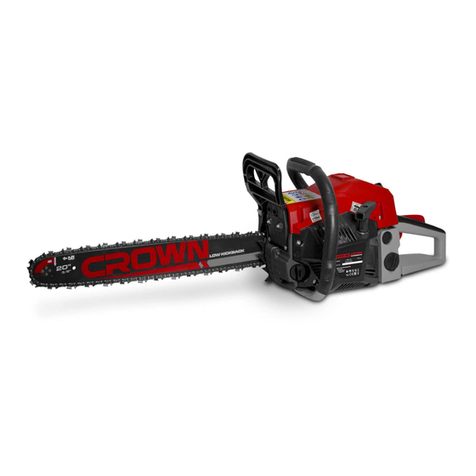
Crown
Crown CT20101-18 Original instructions

Black & Decker
Black & Decker LCS120 instruction manual
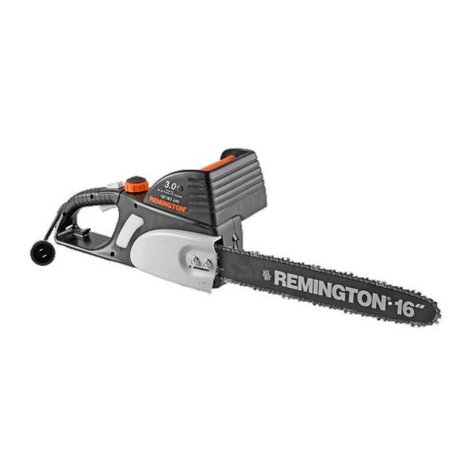
Remington
Remington EL-8: 107624-01, EL-8: 107624- owner's manual

Husqvarna
Husqvarna 340i Operator's manual

Elem Garden Technic
Elem Garden Technic 5411074188795 Original instructions

Hyundai
Hyundai HTRT45H45-1 Original instructions
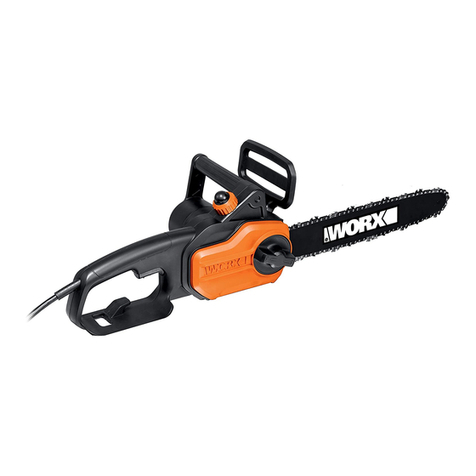
Worx
Worx WG305E Safety and operating manual original instructions
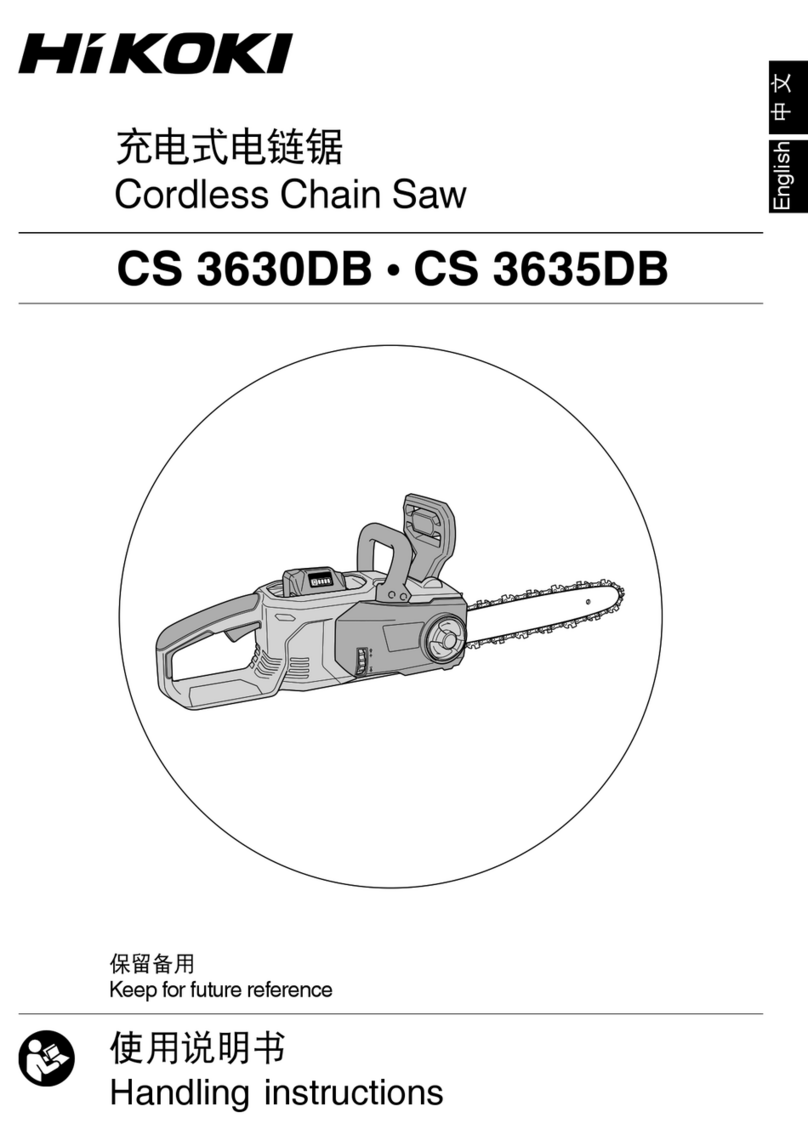
HIKOKI
HIKOKI CS 3630DB Handling instructions

Harbor Freight Tools
Harbor Freight Tools 66908 Set up and operating instructions
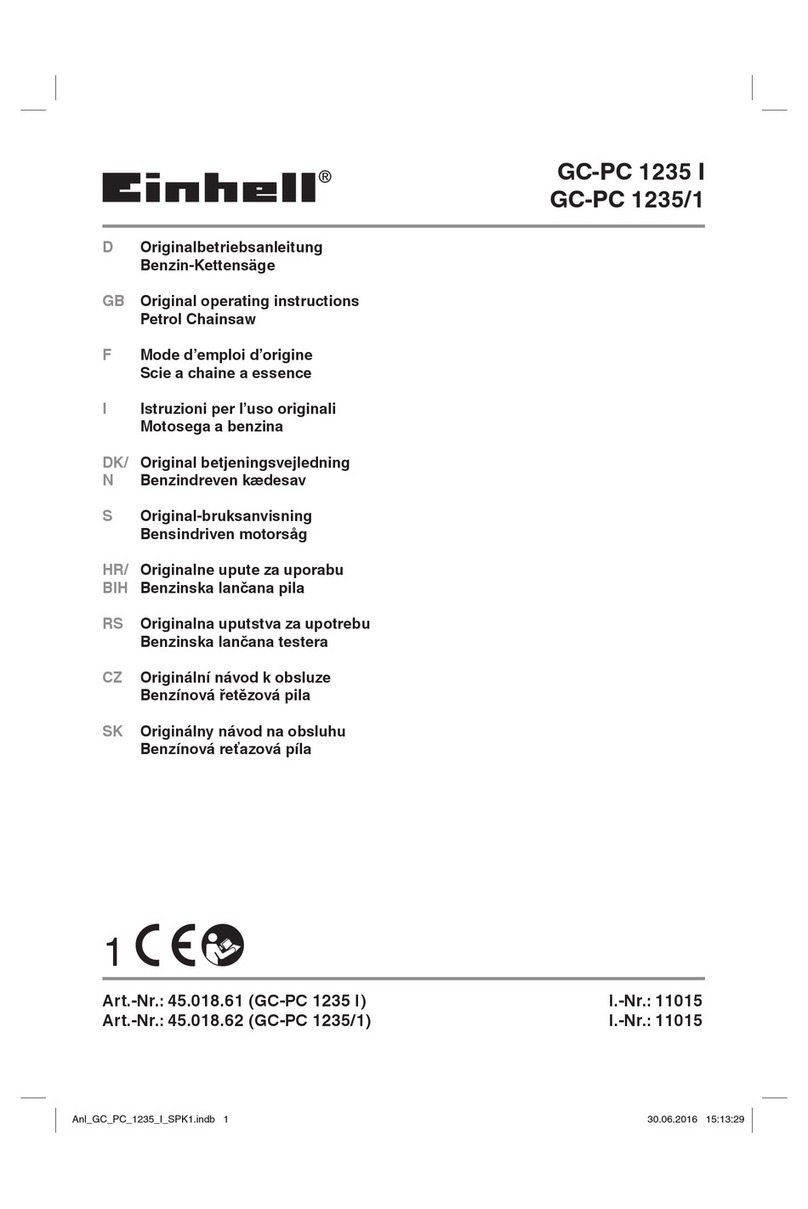
EINHELL
EINHELL GC-PC 1235 I Original operating instructions
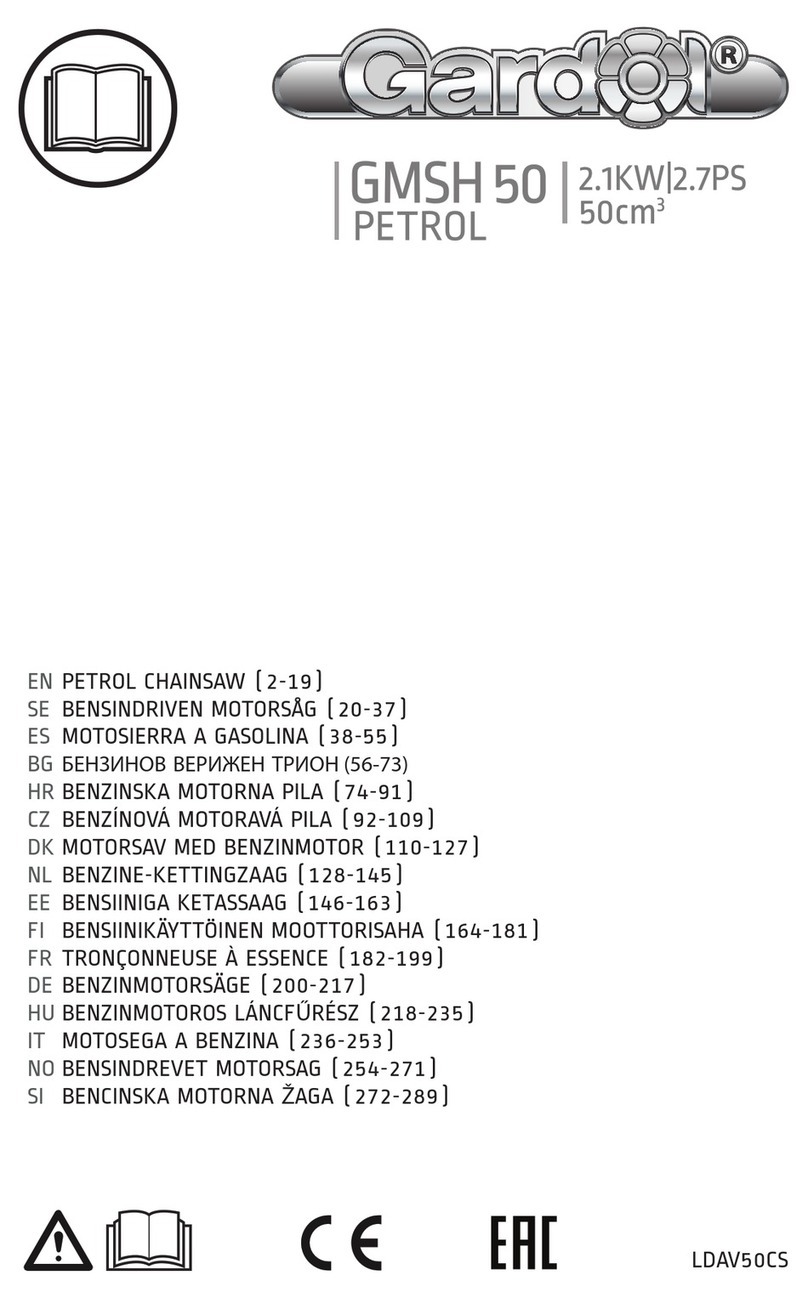
Gardol
Gardol GMSH 50 manual
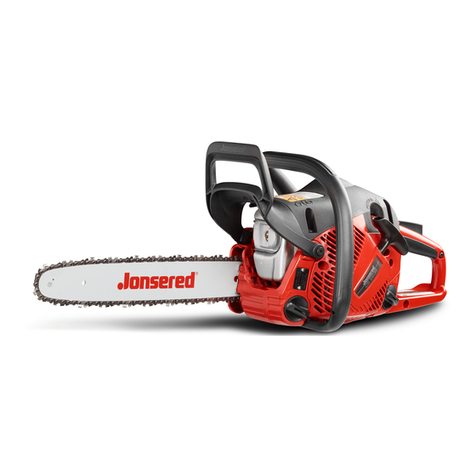
Jonsered
Jonsered CS2234 Operator's manual


